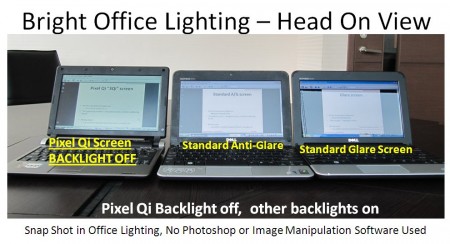When I joined OLPC in 2006, the first thing that blew my mind was the open collaborative process used across the project. The second was Mary Lou Jepsen‘s incredible sunlight-readable screen.
When the first prototype came to our machine lab, I used to stop in every day before heading home, to spend a few minutes looking at it or using it. The displays have a delicious matte quality (the original prototypes had a similar glossy one) that makes anything displayed on them look like a work of art — not unlike the effect of a good matte finish on a photo print, or a tuxedo on the boy next door. And it’s low-power and inexpensive, the sort of technology shift that should become universal.
We have always been open about the tech that goes into our work, in the hopes that other designers and creators will learn from our experiences. And this display, one of the miracles of the XO, has long been something we’ve hoped to see appear in other laptops and devices.
So it has been delightful to watch the growth of PixelQi, Mary Lou’s new company focusing on producing and distributing those displays. Their latest screen is 10.1″ and slightly lower-power and higher contrast than the screen in the XO-1. Here’s a side-by-side comparison of different displays in an office… one of them with its backlight off.

A Pixel Qi screen with its backlight off, next to standard computers with backlights on, in bright office lighting conditions.
Today they announced they have started mass production, and will be on display with some of their first clients in at CES in January.  Technophiles may be lusting after them for indoor use, but we’re looking forward to the day that all netbooks are usable in outdoor classrooms.  To the PixelQi team: congratulations!
=
http://pixelqi.com/



